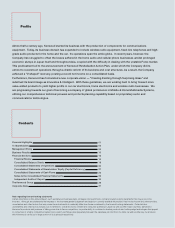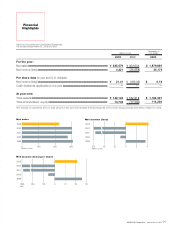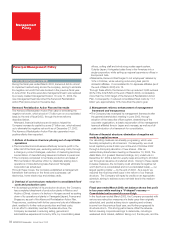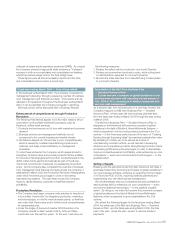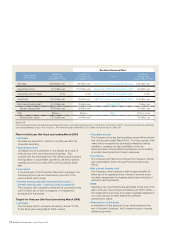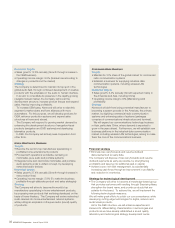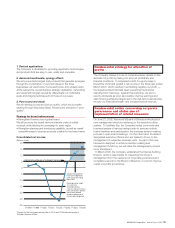Kenwood 2003 Annual Report Download - page 6
Download and view the complete annual report
Please find page 6 of the 2003 Kenwood annual report below. You can navigate through the pages in the report by either clicking on the pages listed below, or by using the keyword search tool below to find specific information within the annual report.
Management
Policy
Principal Management Policy
From reconstruction to rebirth
During the fiscal year ended March 2003, Kenwood did its utmost
to implement restructuring across the company, aiming to eliminate
the negative net worth that was booked in the previous fiscal year.
In June 2002, the entire executive management team was replaced
by a newly created management board. On July 11, 2002, the
new management team launched the Kenwood Revitalization
Action Plan (announced on the same day).
Kenwood Revitalization Action Plan and its results
The Kenwood Revitalization Action Plan calls for eliminating the
negative net worth, which stood at 17 billion yen on a consolidated
basis by the end of fiscal 2003, through the three reforms
described below.
Afterward, financial institutions and investors helped the
Company increase its capital by some 27 billion yen, which allowed
us to eliminate the negative net worth as of December 27, 2002.
The Kenwood Revitalization Action Plan also generated more
positive effects than expected.
1. Reform of business structure: phasing out of unprofitable
operations
• The Home Electronics Business effectively turned a profit in the
latter half of the fiscal year, excluding restructuring costs, through
a change in product strategies, reduction of marketing territories,
concentration of manufacturing bases and cutback in personnel.
• The Company completed to terminate production and sales of
PDC terminals in November 2002, by drastically scaling down
operations of manufacturing base Kenwood Yamagata
Corporation as scheduled.
Through these moves, the Company established a management
framework that centers on the three core businesses: car
electronics, home electronics and wireless radio.
2. Overhaul of cost structure: reduction in consolidated fixed
costs and production costs
• In its sweeping overhaul of its production structure, the Company
has completed divestment of production plants in Mexico and
Huizhou (China), closure of a factory in Hungary as well as scaling
down of its operations at plants in Yamagata (Japan), France and
Singapore, as part of the Kenwood Revitalization Action Plan.
These moves, combined with further personnel cuts at a Malaysian
plant, enabled to further reduce production and fixed costs.
• In an effort to drastically overhaul the sales structure, the
Company succeeded in reducing selling, general and
administrative expenses at home by 30%, by consolidating sales
offices, cutting staff and introducing a sales agent system.
Outside Japan, it integrated sales firms in the Americas into a
single corporation, while setting up regional supervisory offices in
Europe and Asia.
• Meanwhile, Kenwood itself began to cut employees' salaries by
15% in October, while reducing outsourcing fees paid to
domestic affiliates. It consolidated its 19 Japanese affiliates (as of
the end of March 2002) into 12.
Through these efforts, the Kenwood Group reduced 3,965 workers
(45% of the total 8,820 at the end of March 2002), considerably
more than the 3,000 target of the Kenwood Revitalization Action
Plan. Consequently, it reduced consolidated fixed costs by 11.7
billion yen, approximately 10% more than the plan's goal.
3. Management reforms: enhancement of management
framework and transparency
• The Company has revamped its management framework after
the general shareholders' meeting in June 2002, through
adoption of the executive officer system, streamlining of the
corporate organization, a drastic rejuvenation of the management
teams at affiliated firms in Japan and overseas, as well as a full-
scale introduction of a framework for consolidation.
Reform of financial structure: elimination of negative net
worth by capital increase
Our rebuilding measures are steadily progressing, which was
favorably accepted by all concerned. Consequently, we could
boost capital by some 2 billion yen at the end of October 2002
through a third-party allocation of new shares. After an
extraordinary shareholders meeting on December 10, 2002, The
Asahi Bank, Ltd. (present Resona Holdings, Inc.) undertook on
December 27, 2002 a debt-for-equity swap amounting to 25 billion
yen through an issuance of preferred stock. Owing to these capital
increase measures, the Company could eliminate its negative net
worth (both on a consolidated and non-consolidated basis) — our
largest pending matter — by the end of 2002. As a result, we
resolved the most important issue in the reform of our financial
structure. The Company will repay its credits on an appropriate
schedule, aiming to achieve a zero net-debt level in the medium-
range term.
Fiscal year ended March 2003: net balance shows first profit
in four years while marking a "V-shaped" recovery —
Consolidated net income hits record high
In the fiscal year ended March 2003, the Company proceeded with
various reconstruction measures at a faster pace than originally
scheduled, and posted a sharp rise in operating and ordinary
income from the previous fiscal year, and further progressed its
structural reform. This strong performance offset the adverse
factors causing corporate earnings to deteriorate, including a
weakened stock market, deflation taking root, the Iraq war, and the
04 KENWOOD Corporation Annual Report 2003


